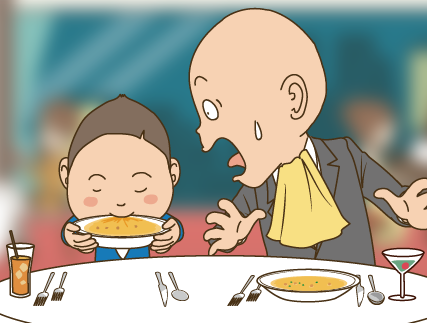Table of Contents
- Parenting cartoon, “What’s the Manner of Meal?”
- Family meals can be fun! Dining Manners Taught by Dad
Parenting cartoon, “What’s the Manner of Meal?”
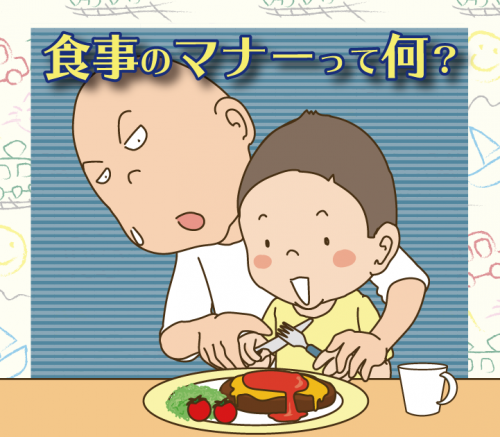

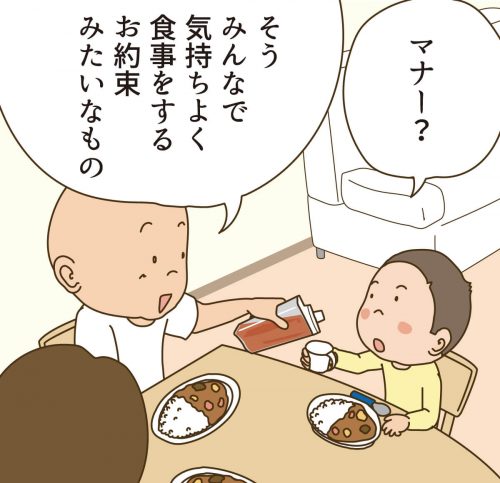
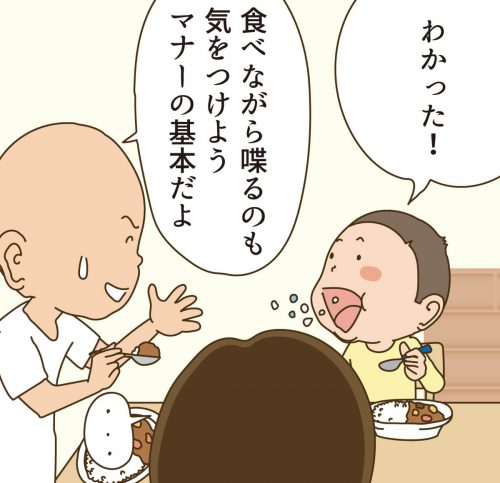
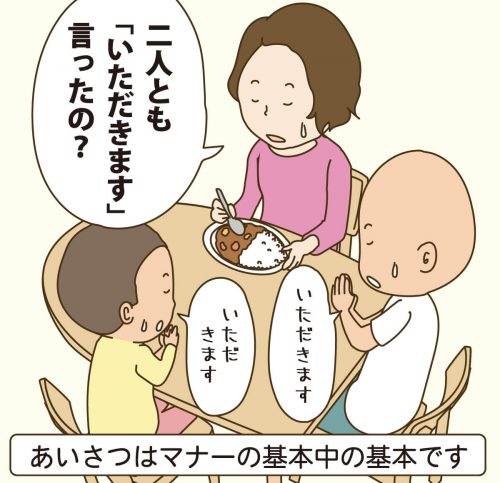

Profile
A1
After working for a design company in Tokyo, he became a freelance illustrator. He is a hard-working father who produces animation, manga, and illustrations, including winning the Yubari International Fantastic Film Festival’s International Short Film Showcase Division Excellence in Animation Award.
Family meals can be fun! Dining Manners Taught by Dad
The manner of the meal is the people you spend the meal with,
It is the kind of care you want to acquire for a pleasant and enjoyable dining experience.
But for young children, it is also difficult to remember.
So this time,
Learn about the manners of eating and how to communicate them that dads want to pass on to their children,
Let’s deepen communication between parents and children through meals.
Know the tips on how to develop good eating manners.
Not making a mess, not leaving food behind, not making noise… There is no end to the list of good eating manners. The list goes on and on, but at the root of it all is to have a pleasant meal together. Ayumi Tamegai, a former kindergarten teacher who now works for Japan Kids. We interviewed Ms. Tamegai, a former kindergarten teacher and current board member of the Japan Kids Nutrition Education Association, about meal manners.
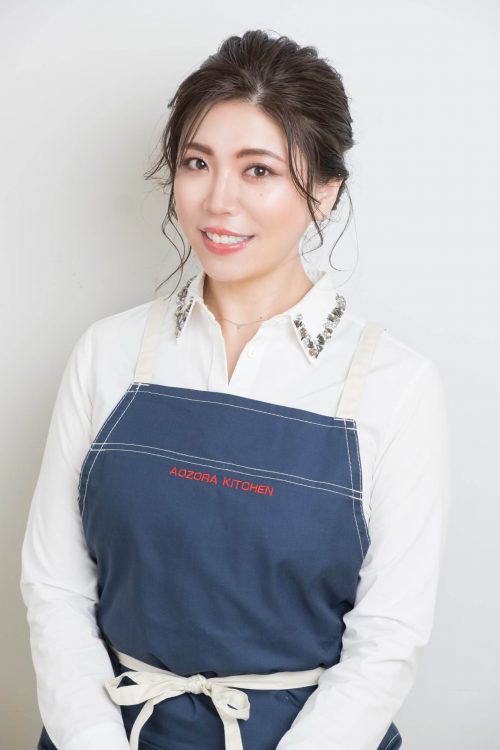
Let’s remember to take time to appreciate and enjoy food.
I believe that the reason why parents want their children to learn good eating manners is because they are concerned that their children may cause trouble for someone else when they are not looking out for them. Therefore, they try to force their children to learn even if it is still difficult for them in their developmental stage. Instead of forcing children to learn, we should keep in mind that children should “naturally learn”.
The initial goal may vary from person to person, but it is better to set a simple goal, such as, “When I go to elementary school, I want to be able to eat dinner with everyone on time.” It is better to set a goal as simple as this.
It is not easy to learn the manners of eating from the beginning. Before eating cleanly and without making a mess, it is a good idea to learn the two manners of “appreciating the meal” and “making the meal a pleasant time.
Saying “Itadakimasu” and “Gochisosama,” not leaving food, not liking or disliking food, and not playing with food can be learned little by little by knowing the process of eating and feeling gratitude.
Also, in order to teach children to enjoy eating, try not to give them too much attention. For example, a child may not be hungry at a mealtime set by an adult. Sitting and eating for more than 10 minutes under such circumstances can be painful for the child. Be aware that repeatedly warning the child may cause the child to find eating a boring time and even lose interest in food.

You also need to change your response depending on whether the child is spilling on purpose or spilling because he/she is unable to eat well. If it is the former, teach them the importance of food; if it is the latter, tell them what they can do little by little.
Children are not yet able to judge what is good and what is not. Therefore, the key is to “praise” them when they do something good. By praising, the child learns what is right and moves on to the next step.
Dining etiquette starts with the simple things.
Eating manners should be stepped up gradually according to age and developmental status.
Fat to about 3 years old
The first step is to teach them to sit up straight. By having Mom or Dad sit facing you, you will be able to sit facing forward. Tell them, “If your belly button is not facing the desk, it will be hard for you to eat your food and it will spill.” This is a good way to teach your child to sit facing the table.
Next is greetings. It is good to be able to say “Itadakimasu” and “Gochisosama” at this age. It would be wonderful if they can say them with all their hearts so that they can reach their parents who prepared the meal and the producers of the food.
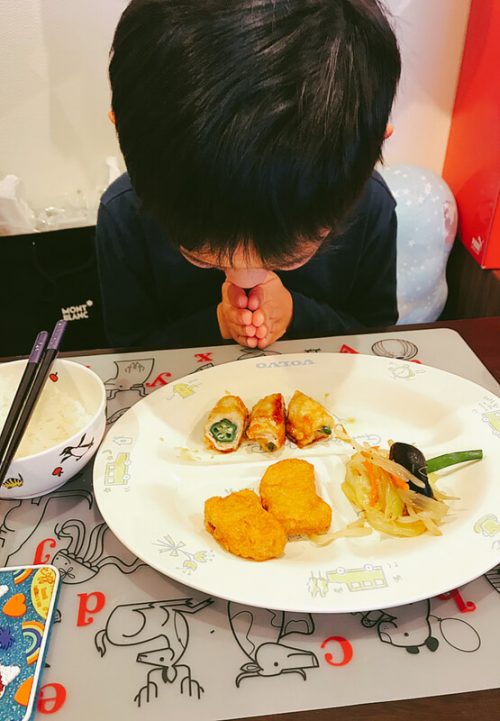
Gradually, the child will start using a spoon or other utensil to scoop and eat. Here, focus not on the spills, but on the rhythm of swallowing and chewing. Learn to eat the food in your own time and in your own way. If the child spills or is unable to eat well, make sure that the environment is created for successful eating.
For example, if the food is on the front side of the desk or within arm’s reach, it will be dropped. If a child has difficulty eating a piece of food and it falls out of his or her mouth, the food may be too large. Learning to cut the food in half on the plate and thinking about what size would be comfortable for them to eat is also necessary for them to take the next step.

In addition, some children’s lunches have a variety of rice served on a single plate, and it is a difficult process to eat rice without spilling it. Therefore, one of the considerations is to create an easy-to-eat situation, such as serving the rice in a separate bowl. Parents should be tolerant and take the stance of praising the child when he or she does well. This will allow the child to grow without compromising his or her sense of self-esteem.
Fat: Before entering elementary school
At this age, muscle strength develops and the use of fingers becomes more skillful. Therefore, it is a good time for them to learn the correct way to hold chopsticks and other objects.
Next, we tell them the importance of eating well without leaving any leftovers. In doing so, it is counterproductive if mom or dad tries to force it on them. For example, how about telling them, “You should eat a lot of food in order to have a good time at the park?” How about telling them, “You should eat a lot in order to play well at the park?
Children cannot verbalize why they cannot or do not want to eat. Adults can voluntarily refrain from eating fatty foods when they have an upset stomach, but children do not have that option. When they cannot eat, there is some other reason. It may be that the way the food was prepared did not suit their taste buds. It is important to observe the child’s condition carefully.
Communication that makes you love to eat.
Although we try to have a pleasant family meal, there may be times, for example, when the children play with the food or make a mess of the meal. When this happens, instead of getting angry, tell them, “Mom and Dad are sad when they do that.
For moms and dads who are too busy with work to have meals together, it is enough just to have a conversation like, “How was dinner today? It is enough just to have a conversation like “How was your dinner today? The most important thing in meal manners is to enjoy the meal. Let’s make sure that mealtime is not a painful experience.

Forcing manners on a child because of adult ego can make mealtime a painful experience for the child. Simply sitting still is not easy for children.
It is important for children to grow up with a tolerant heart, not only when eating but also when raising children. Let’s think together with our children about what we can do to ensure that everyone who shares a meal with us has a pleasant time without unpleasantness, while teaching them good manners.




